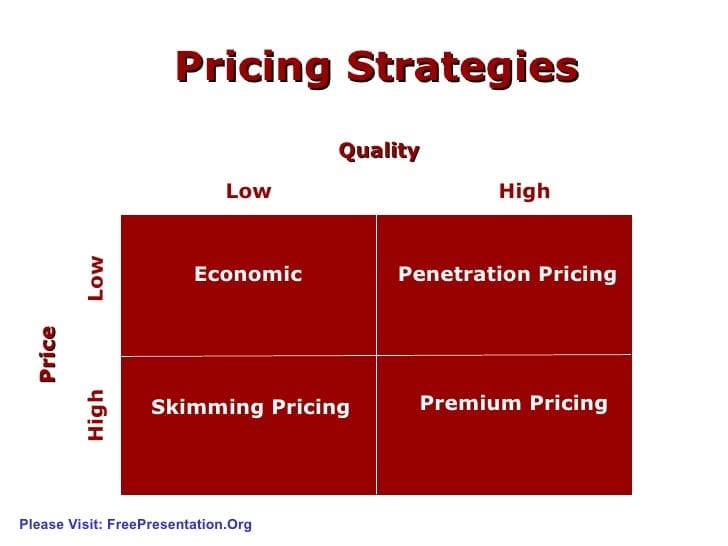Just how to Adjust Your Pricing Strategy for Different Market Segments
Just how to Adjust Your Pricing Strategy for Different Market Segments
Blog Article
Optimize Revenue With Proven Prices Method Techniques
Techniques such as value-based pricing, vibrant rates, and complete market analysis can dramatically improve a company's economic efficiency. Recognizing customer assumption and leveraging information analytics for dexterous pricing adjustments are vital parts of this approach.
Recognizing Customer Perception
Recognizing consumer assumption is important for creating reliable pricing methods. It affects how consumers examine an item's value, top quality, and overall beauty. Businesses must recognize that clients typically base their desire to pay not entirely on the product's innate qualities but also on psychological elements, consisting of brand credibility, social condition, and viewed deficiency.

Furthermore, companies should take into consideration the role of prices psychology, such as beauty prices or price anchoring, which can dramatically influence customer behavior. Understanding these understandings enables organizations to mount their rates approaches in a way that straightens with customer expectations while taking full advantage of productivity.
Integrating consumer understanding right into rates strategies not just aids in setting competitive prices however also cultivates brand name loyalty, as customers really feel recognized and valued. Eventually, a nuanced understanding of customer assumption can cause lasting income growth and enhanced market positioning.
Analyzing Market Trends
To create an effective pricing method, analyzing market patterns is crucial for businesses wanting to stay affordable. Comprehending the dynamics of market variations makes it possible for firms to make informed decisions relating to prices changes, product launches, and resource appropriation - Pricing Strategy. By keeping track of customer behavior, economic indicators, and market growths, organizations can recognize patterns that inform their rates structures
Key parts to think about when examining market trends include demand elasticity, seasonal fluctuations, and arising technologies. Demand elasticity helps services determine how price modifications might impact customer getting choices. Seasonal patterns can supply insights right into optimum rates throughout optimal and off-peak periods, enabling strategic discounting or promotional prices. Additionally, watching on technological advancements can aid recognize possible risks or opportunities that could influence pricing techniques.
Using data analytics tools can boost the accuracy of pattern evaluation, providing valuable insights that assist in nimble decision-making. Firms need to additionally think about carrying out routine market study to verify presumptions and adapt to progressing consumer preferences. By leveraging these understandings, organizations can not just enhance their pricing techniques but also enhance their overall market setting, making certain lasting profitability and growth.
Affordable Pricing Approaches
An affordable pricing method is vital for companies aiming to gain a side in a congested marketplace. By analyzing rivals' rates structures and market positioning, companies can strategically establish their prices to draw in consumers while preserving earnings. This strategy requires a detailed understanding of both the affordable landscape and client perceptions of worth.
One efficient technique is price matching, where a business offers to defeat a rival or match's cost. This tactic can boost consumer loyalty and urge sales, specifically in price-sensitive markets. Additionally, penetration prices can be employed to catch market share by at first setting costs less than competitors, attracting clients to attempt the item and cultivating brand name awareness.
Additionally, businesses can execute emotional pricing techniques, such as pricing items simply listed below a rounded number (e.g., $9.99 instead of $10 - Pricing Strategy.00) This can produce the understanding of a far better deal, affecting consumer behavior
Inevitably, a successful affordable pricing strategy stabilizes the need to continue to be attractive to consumers while guaranteeing that the prices model aligns with the company's general objectives. Frequently readjusting and reviewing pricing in reaction to market shifts and competitor activities is important for continual success.
Value-Based Prices Techniques
Value-based prices techniques concentrate on establishing prices primarily based upon the perceived worth of a product and services to the customer, rather than exclusively on production expenses or competitor prices. This technique calls for a deep understanding of client needs, preferences, and the unique advantages that the service or product offers. By identifying the particular value vehicle drivers that reverberate with consumers, services can develop pricing strategies that show truth well worth of their offerings.
To apply value-based see post rates effectively, firms have to involve in thorough market research study, consisting of client surveys and focus teams, to collect insights right into consumer understandings. Furthermore, businesses ought to segment their customer base to customize prices strategies that align with different value assumptions throughout segments.
Communication plays an important function in value-based pricing; firms must verbalize the unique worth proposal clearly to warrant the cost point. In addition, recurring examination and change are crucial, as client understandings of worth might shift gradually due to market characteristics or affordable activities. By prioritizing worth in pricing techniques, companies can boost consumer fulfillment, enhance commitment, and eventually maximize revenue.
Dynamic Prices Versions

Dynamic pricing leverages innovative algorithms and data see this analytics to keep an eye on competitor rates, customer actions, and supply degrees. By dynamically readjusting costs, companies can maximize earnings, maximize profit margins, and respond promptly to changes in the market. For instance, airline companies frequently use this model to change ticket costs based upon variables like continuing to be seats, time till departure, and competitor pricing.
However, the application of dynamic rates need to be come close to with caution. Transparent interaction with clients is necessary to keep count on and stay clear of perceptions of unfair prices methods. In addition, companies must make certain that their rates formulas are not overly intricate or nontransparent, as this can cause consumer frustration.
Ultimately, when performed thoughtfully, dynamic rates models can offer businesses with a significant competitive advantage, permitting them to profit from market opportunities while accommodating consumer expectations in a rapidly transforming economic landscape.
Conclusion

Methods such as value-based rates, dynamic pricing, and comprehensive market evaluation can significantly boost a business's financial efficiency. Seasonal fads can offer insights right into ideal prices during top and off-peak periods, permitting for tactical discounting or promotional pricing.Dynamic rates leverages sophisticated formulas and information analytics to keep track of rival rates, customer actions, and inventory levels. By understanding customer perception, assessing market fads, and applying competitive pricing approaches, get redirected here services can properly align their pricing with consumer expectations. Furthermore, value-based pricing and vibrant rates models allow companies to respond agilely to market changes.
Report this page